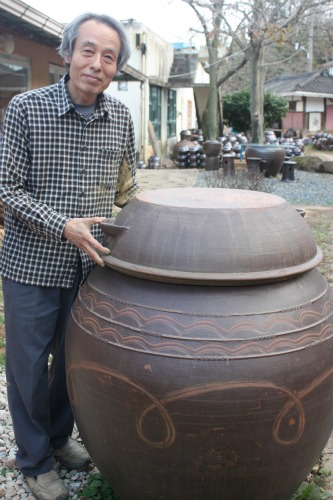중요무형문화재 제96호 이학수 옹기장 기능보유자
A piece of earthenware present in any Korean household, onggi has survived the passage of time. Through the years, the special characteristics of this earthenware did not only protect the nutrition of Korean households but has shaped the Korean food culture as a whole. Not seen from most people, however, is the hard work of the potters behind this humble earthenware, potters who have dedicated their lives to perfection. A life of learning and molding his emotions to the pots that he creates, Lee Hak-su, artisan of Miryeok Onggi, tells the story behind this well-loved creation from clay.

Miryeok Onggi in Boseong Country, South Jeolla is the workshop of Important Intangible Cultural Property No. 96, Onggijang, the late Lee Ok-dong, the master artisan for the spiral corkscrew style of making earthenware. The spiral corkscrew style is prevalent in Namdo where the artisan uses elongated slabs of clay stacked to each other to create the pot. This allows the artisan to create pots in various sizes and Miryeok Onggi specifically is famous for making up-sized earthenware. Currently, his son, artisan Lee Hak-su inherited the workshop and is continuing this legacy, being the 9th generation from a line of potters ever since the Joseon Dynasty. “Originally, my forefathers were from Gangjin but after sometime moved to Boseong where the work of my family has strived for three generations now. While this work takes a lifetime to learn, I hope that this legacy continue to live on to the future generations.” In another interview, artisan Lee conveyed his high hopes that his son will continue his work.
Pottery in Korean culture plays a vital role in the past. However, in comparison to onggi, Goryeocheongja, jade-green celadon and Baekja, white porcelain from the Joseon Dynasty, plays a central role as the noble class and foreign traders focus on these products of high artistry. The humble onggi left in the abodes continue to strive through the generations and its functions eventually developed.

Making onggi starts with working with the clay harvested from the mountains or the fields. Artisan Lee explains that there are two colors of onggi: brown and golden yellow. Namdo is rich in golden yellow-producing clay as it receives from sunshine than the northern regions. After soaking it overnight and sifting through the impurities and air bubbles, the clay slabs are prepared. Making elongated slabs for pottery is a prerequisite for the spiral corkscrew style of Miryang Onggi. The pot will be set to dry out for the few days to release the air bubbles within it. After which, it will be glazed and be set out for drying once more. Once it is fully ready, it will be put in the furnace for almost one week. Not all of pots will survive—those who cannot stand the firing and last process are broken down into tiny pieces and are buried from where they came from, the earth, to become one of it once more. In this process, artisan Lee explains that 10 people are needed to create a masterpiece.
Apart from the detail needed to create onggi, artisan Lee explains about the learning he realized through a dedicated life as a potter. “Clay in itself is a non-living thing. But by making onggi, clay becomes impersonated. Clay is honest, but humans change because of different emotions. When I am in front of clay, I feel smaller. As I look at an honest thing such as clay, it becomes my mirror and I feel ashamed of myself.” He says that the impersonification of clay comes from the emotions of the master and it does not once the master moves it. Being still in a flat surface, it can contain a material to its brim. Artisan Lee says that onggi reflects what kind of people we need to be: focused and unwavering, knowing our role and fulfilling it for the greater benefit of the society, a lesson he would like to partake. “Nowadays, young people are at unease, always impulsive in their decisions. This will not enable them to realize their full potential for their own and society’s benefit. Being still and understanding your surroundings until the tides of change move one for a higher cause will enable one to achieve the highest benefit.” Artisan Lee is moved, he says, not by the artistic beauty that in reflected in his work but by the fact that he lives learning day by day from the lessons that he acquires in front of onggi. The humbleness of making onggi and the simple yet vital role of this earthenware that has survived hundreds of years resembles the true meaning of self-enlightenment. Through onggi, Lee Hak-su hopes that more people will be encouraged to look back at their steps to recalibrate their future.
By Rigoberto Banta Jr., Head Student Editor
Rigoberto Banta Jr. 기자
tribune1968@cnumedia.com

